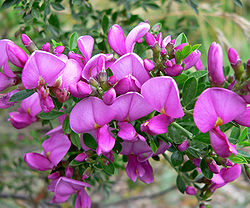| Cladrastis clade | |
|---|---|
 | |
| Pickeringia montana | |
| Scientific classification | |
| Kingdom: | Plantae |
| Clade: | Tracheophytes |
| Clade: | Angiosperms |
| Clade: | Eudicots |
| Clade: | Rosids |
| Order: | Fabales |
| Family: | Fabaceae |
| Subfamily: | Faboideae |
| Clade: | Cladrastis clade (Wojciechowski et al. 2004 [1] ) Wojciechowski 2013 [2] |
| Genera [3] | |
| |
| Synonyms | |
| |
The Cladrastis clade is a monophyletic clade of the flowering plant subfamily Faboideae (or Papilionaceae) that is found in eastern Asia and southern North America. [2] [3] [4] It is consistently resolved in molecular phylogenies and is sister to the Meso-Papilionoideae. [1] [3] [4] [5] [6] [7] [8] [9] [10] Evidence for the existence of this clade was first proposed based on morphological (floral), cytological, and biochemical evidence. [11] [12] It is predicted to have diverged from the other legume lineages 47.4±2.6 million years ago (in the Eocene). [13]